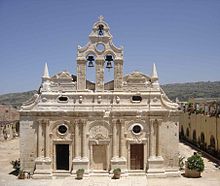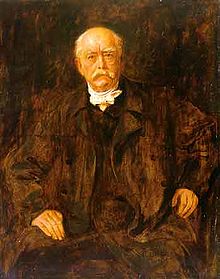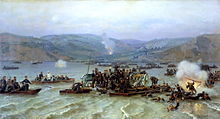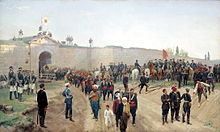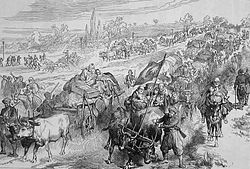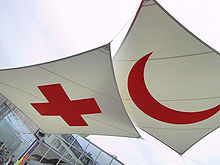- Russo-Turkish War (1877–1878)
-
Russo-Turkish War (1877–1878) 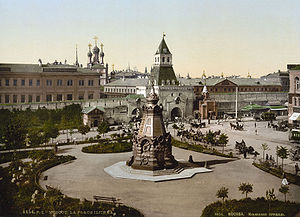
Plevna Monument near the walls of Kitai-gorodDate April 24, 1877 – March 3, 1878 Location Balkans, Caucasus Result Russian victory
Treaty of San Stefano, Treaty of BerlinTerritorial
changesReestablishment of the Bulgarian state; full independence of Romania, Serbia and Montenegro from Ottoman Empire; Kars becomes a part of the Russian Empire Belligerents  Russian Empire
Russian Empire
 Bulgarian volunteers
Bulgarian volunteers
 Romania
Romania
 Serbia
Serbia
 Montenegro
Montenegro Ottoman Empire
Ottoman EmpireCommanders and leaders  Mikhail Skobelev
Mikhail Skobelev
 Michael Nikolaevich
Michael Nikolaevich
 Mikhail Loris-Melikov
Mikhail Loris-Melikov
 Joseph Gourko
Joseph Gourko
 Ivan Lazarev
Ivan Lazarev
 Carol I of Romania
Carol I of Romania
 Kosta Protić
Kosta Protić Ahmed Pasha
Ahmed Pasha
 Osman Pasha
Osman Pasha
 Suleiman Pasha
Suleiman Pasha
 Mehmed Pasha
Mehmed Pasha
 Veisel Pasha
Veisel PashaStrength Russia — 737,355
500 cannons[1]
Romania — 60,000
190 cannons
Bulgaria — 40,000
Serbia — 81,500
Montenegro — 25,000Ottoman Empire — 281,000[2] Casualties and losses Russia — 15,567 killed in battle,
6,824 died from wounds,
81,363 died from disease,
1,713 dead from other causes,
3,500 missing,
56,652 wounded,
35,000 released from service as no longer fit for service[3]
Romania: 4,302 dead and missing, 3,316 wounded, 19,904 sick.[4]
Bulgaria — 15,000 dead and wounded[citation needed]
Serbia — 5,000 dead and wounded[citation needed]
Montenegro— 5,000 dead and wounded[citation needed]30,000 killed, 90,000 died from sickness[citation needed] - Kızıl-Tepe
- Simnitza
- Svistov
- Nikopol
- 1st Shipka Pass
- 2nd Shipka Pass
- Lovcha
- 3rd Shipka Pass
- Gorni-Dubnik
- Kars
- Plevna
- Tashkessen
- 4th Shipka Pass
- Philippopolis
The Russo-Turkish War of 1877–1878 (Bulgarian: Руско-турска освободителна война (1877—1878 г.), Russian: Русско-турецкая война (1877—1878 гг.), Ottoman: ۹۳ حربی, Doksan Üç Harbi ('93 Harbi, "93 War"), Turkish: '93 Harbi or 1877–78 Osmanlı-Rus Savaşı) was a conflict between the Ottoman Empire and the Eastern Orthodox coalition led by the Russian Empire and composed of numerous Balkan countries. Fought in the Balkans and in the Caucasus, its origins lie in emerging nineteenth-century nationalism in the Balkan region. Additional factors include the Russian aspirations of recovering territorial losses it had suffered during the Crimean War, reestablishing itself in the Black Sea and supporting the political movement attempting to free Balkan nations from the Ottoman Empire.
As a result of the war, Russia succeeded in claiming several provinces in the Caucasus, namely Kars and Batum. The principalities of Romania (which was also forced by Russia to cede the Budjak region of the Danube delta, in spite of an existing treaty of alliance between the two countries), Serbia and Montenegro, each of which had had de facto sovereignty for some time, formally proclaimed independence from the Ottoman Empire. After almost five centuries of Ottoman domination (1396–1878), the Bulgarian state was reestablished as the Principality of Bulgaria, covering the land between the Danube River and the Balkan Mountains (except Northern Dobrudja which was given to Romania) as well as the region of Sofia, which became the new state's capital. The Congress of Berlin also allowed Austria-Hungary to occupy Bosnia and Herzegovina and the United Kingdom to take over Cyprus.
Contents
Conflict pre-history
Treatment of Christians in the Ottoman Empire
Article 9 of the 1856 Paris Peace Treaty, concluded at the end of the Crimean War, obliged the Ottoman Empire to grant Christians equal rights with Muslims. An edict, Hatt-ı Hümayun, was issued that proclaimed the principle of the equality of Muslims and non-Muslims,[5] and produced some specific reforms to this end. For example, the jizya tax was abolished and non-Muslims were allowed to join the army.[6]
However, some key aspects of Dhimmi status were retained; for example, the testimony of Christians against Muslims was not accepted in courts, which granted Muslims effective immunity for offenses conducted against Christians. Although on a local level, relations between communities were often good, this practice encouraged the worst elements of Muslim society to exploit the situation. The abuses were at their worst in regions with a predominantly Christian population, mainly located in the European part of the empire, where local authorities often openly supported them as a means to keep Christians subjugated.[7]
The financial strain on the treasury caused by the Crimean War forced the Ottoman government to take a series of foreign loans at such steep interest rates that, despite all the fiscal reforms that followed, pushed it into unpayable debts and economic difficulties. This was further aggravated by the need to accommodate more than 600,000 Muslim Circassians, expelled by the Russians from the Caucasus, to the Black Sea ports of north Anatolia and the Balkan ports of Constanţa and Varna, which cost a great deal in money and in civil disorder to the Ottoman authorities.[8]
Crisis in Lebanon, 1860
In 1858 the Maronite peasants, stirred by the clergy, revolted against their Maronite feudal overlords and established a peasant republic. In southern Lebanon, where Maronite peasants worked for Druze overlords, Druze peasants sided with their overlords against the Maronites, transforming the conflict into a civil war. Although both sides suffered, about 10,000 Maronites were massacred at the hands of the Druzes.[9][10]
In Syria, events in Lebanon stirred the Muslim population of Damascus to attack the Christian minority with between 5,000 to over 25,000 of the latter being killed,[citation needed] including the American and Dutch consuls, giving the event an international dimension.
Under the threat of European intervention, Ottoman authorities restored order. Nevertheless, French and British intervention followed.[11] Under further European pressure, the Sultan agreed to appoint a Christian governor in Lebanon, whose candidacy was to be submitted by the Sultan and approved by the European powers.[9]
The revolt in Crete, 1866–1869
The Cretan revolt of the period was the result of two things: the failure of the Ottoman Empire to apply reforms for improving the life of the population and the Cretans' desire for Enosis — union with Greece.[12] The insurgents gained control over the whole island, except for five cities where the Muslims were fortified. The Greek press claimed that Muslims had massacred Greeks and the word was spread throughout Europe. Thousands of Greek volunteers were mobilized and sent to the island.
By early 1869 the insurrection was suppressed, but the Porte offered some concessions, introducing island self-rule and increased Christian rights on the island. The siege of Moni Arkadiou monastery, when about 150 predominantly male, Cretan Greek combatants accompanied by about 600 women and children were besieged by about 23,000 mainly Cretan Muslims aided by Ottoman troops, became widely known in Europe. After a bloody battle with a large number of casualties on both sides, the Cretan Greeks finally surrendered when their ammunition ran out but were killed upon surrender.[13]
An important effect of the Cretan insurrection, and especially the brutality with which it was suppressed by the Ottomans, was the growth of public attention in Europe, and in Great Britain in particular, to the issue of the oppressed state of the Christians in the Ottoman Empire.
"Small as the amount of attention is which can be given by the people of England to the affairs of Turkey … enough was transpiring from time to time to produce a vague but a settled and general impression that the Sultans were not fulfilling the “solemn promises” they had made to Europe; that the vices of the Turkish government were ineradicable; and that whenever another crisis might arise affecting the “independence” of the Ottoman Empire, it would be wholly impossible to afford to it again the support we had afforded in the Crimean war."[14]
The crisis came to an end, with the Ottomans more victorious than they had been or would be in almost any other diplomatic confrontation during the century.
Changing balance of power in Europe
The New European Concert
The concert of Europe established in 1856 was shaken in 1859 when France and Austria fought over Italy. It came apart completely as a result of Bismarck's wars to create a united Germany, with Prussia defeating Austria in 1866 and France in 1870, thus establishing itself in place of Austria-Hungary as the dominant power in Central Europe. Britain, worn out by its participation in the Crimean War and diverted by the Irish question and the whole complex of problems created by the Industrial Revolution, chose not to intervene again to restore the European balance. Bismarck did not wish the breakup of the Ottoman Empire to create rivalries that might lead to war. So he took up the Tsar's earlier suggestion that arrangements be made in case the Ottoman Empire fell apart, creating the Three Emperors' League with Austria and Russia to keep France isolated on the continent. France responded by supporting self-determination movements, particularly if they concerned the three emperors and the Sultan. Thus revolts in Poland against Russia and national aspirations in the Balkans were encouraged by France. Russia worked to regain its right to maintain a fleet on the Black Sea and vied with the French in gaining influence in the Balkans by using the new Pan-Slavic idea that all Slavs should be united under Russian leadership. This could be done only by destroying the two empires where most of the non-Russian Slavs lived, the Habsburg and the Ottoman. The ambitions and the rivalries of the Russians and French in the Balkans surfaced in Serbia, which was experiencing its own national revival and had ambitions that partly conflicted with those of the great powers.[15]
Changing balance of power in Europe
Russia ended the Crimean War with minimal territorial losses, but was forced to destroy its Black Sea Fleet and Sevastopol fortifications. Russian international prestige was damaged, and for many years revenge for the Crimean war became the main goal of Russian foreign policy.
This was not easy however — the Paris Peace Treaty included guarantees of Ottoman territorial integrity by Great Britain, France and Austria; only Prussia remained friendly to Russia.
It was on alliance with Prussia and its chancellor Bismarck that the newly appointed Russian chancellor, Alexander Gorchakov, depended. Russia consistently supported Prussia in her wars with Denmark (1864), Austria (1866) and France (1870). In March 1871, using the crushing French defeat and the support of a grateful Germany, Russia achieved international recognition of its earlier denouncement of Article XI of the Paris Peace Treaty, thus enabling it to revive the Black Sea Fleet.
Other clauses of the Paris Peace Treaty, however, remained in force, specifically Article 8 with guarantees of Ottoman territorial integrity by Great Britain, France and Austria. This made Russia use extreme caution in its relations with the Ottoman empire and coordinate all its actions with other European powers. A Russian war with Turkey would require at least the tacit support of all other Great Powers, and Russian diplomacy was waiting for a convenient moment.
Situation in the Balkans
The balance of power in Europe directly reflected the situation on the Balkan peninsula. The state of Ottoman administration continued to deteriorate throughout the course of 19th century, with the central government occasionally losing actual control over whole provinces. Reforms imposed by European powers did little to improve the conditions of the Christian population, while managing to dissatisfy a sizable portion of the Muslim population. Bosnia and Herzegovina suffered at least two waves of rebellion by the local Muslim population, the most recent in 1850.
Austria consolidated after the turmoil of the first half of the century and sought to reinvigorate its longstanding policy of expansion at the expense of the Ottoman empire.
The nominally autonomous, de facto independent principalities of Serbia and Montenegro sought the opportunity to expand into regions inhabited by their Serbian compatriots. The situation in Serbia was especially complicated. The principality made expansion to neighboring Serbian inhabited areas, south Serbia, Kosovo, and Bosnia its priority. The ruling House of Obrenović enjoyed good connections with Vienna, and was at first reluctant to risk a military adventure against the Ottoman empire. However public opinion was heavily pro war, encouraged by the diplomatic victory of 1862 and the expulsion of Ottoman troops from their last garrisons on the territory of the principality. The presence of Russian agents was also very strong.
Montenegro, ruled by the ambitious Prince Nikola, was in a position to advocate a much more adventurous policy. When an uprising of orthodox Christians erupted in Herzegovina in 1875, Montenegrins promptly intervened to help their fellow tribesmen, declaring war on the Ottoman empire. Soon an uprising in Bulgaria erupted. Compelled by these events and by overwhelming pressure from the public, prince Milan Obrenović declared war on the Ottoman empire in 1876.
Balkan crisis of 1875–1876
From 1873 onward the Ottoman government was faced with a period of drought and famine in Anatolia, leading to widespread misery and discontent. Agricultural shortages became such as to preclude the collection of necessary taxes. This reached the point at which the Imperial Treasury was left without adequate funds for the business of government. The result was a major financial collapse which forced the Ottoman government to declare bankruptcy in October, 1875.
An anti-Ottoman uprising occurred in Bosnia and Herzegovina in the summer of 1875. The main reason for this revolt was the heavy tax burden imposed by the cash-starved Ottoman administration. Both Montenegro and Serbia intervened with armed bands. Despite some relaxation of taxes, the uprising continued well after the end of 1875 and eventually triggered the Bulgarian April uprising of 1876.
The Bulgarians' 1876 April uprising
Since autumn of 1875, the Ottoman authorities were aware that a revolt was being considered. They had, therefore, increased their patrols on the Danube and sent more spies and agent provocateurs into Bulgarian areas, where they did considerable damage to the revolutionaries' infrastructure.[16] They sought swift and complete independence through armed rebellion modeled after the uprising of the Serbs and Greeks, and they looked to Orthodox Russia and Serbia for support.[17] The revolt of Bosnia and Herzegovina spurred the Bucharest-based Bulgarian revolutionaries into action. A Bulgarian uprising was hastily prepared to take advantage of Ottoman preoccupation, but it fizzled before it started. In the spring of 1876 another uprising erupted in the south-central Bulgarian lands. That event was even more haphazardly planned than the previous one. The rebels were ill-armed and disorganized. According to Dennis Hupchick "The ill-armed and disorganized rebels did little more than publicly rally, sing newly written patriotic songs, and butcher their mostly pacific Muslim neighbors."[18] However, according to a report submitted to the British foreign office in 1877, "not one single Turkish woman or child" and only 46 "Turkish men" (who were "always armed") were reported killed by insurgents.[19]
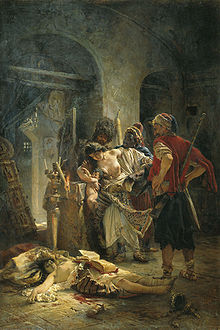 Konstantin Makovsky. The Bulgarian martyresses, a painting depicting the atrocities of bashibazouks in Bulgaria.
Konstantin Makovsky. The Bulgarian martyresses, a painting depicting the atrocities of bashibazouks in Bulgaria.
The Ottomans, lacking adequate regular troops because of the problems in the northwest, were compelled to use irregular Bashi-bazouks to quell the Bulgarians. (May 11-June 9, 1876) Those irregulars mostly were drawn from Muslim inhabitants of the Bulgarian regions, many of whom were Circassian refugees expelled from the Caucasus or Crimean Tatar refugees expelled during the Crimean War. Making little distinction between rebels and passive peasants, bashi-bazouks, true to their reputation, brutally suppressed the revolt, massacring up to 15,000[20][21] people in the process. Between a thousand and twelve hundred people, mostly women and children, took refuge in a church at Batak and were then burnt alive.[22][23] Five thousand out of the seven thousand villagers of Batak "were put to death" [24] According to some sources, both Batak and Perushtitsa, where the majority of the population was also massacred, had not participated in the rebellion.[21] Many of the perpetrators of those massacres were latter decorated by the Ottoman high command[21]
News of the massacres of Bulgarians filtered into Britain from missionaries, journalists, and diplomatic agents in the Balkans. The British press trumpeted the charge of "Bulgarian Horrors" reporting that thousands of defenceless Christian villagers had been slaughtered by fanatical Muslims. American missionaries estimated that as many as 15,000 Christians had been killed, and Bulgarian historians give estimates from 30,000 to 100,000.[25]
International reaction to atrocities in Bulgaria
Word of the bashi-bazouks' atrocities filtered to the outside world by way of American-run Robert College located in Constantinople. The majority of the students were Bulgarian, and many received news of the events from their families back home. Soon the Western diplomatic community in Constantinople was abuzz with rumours, which eventually found their way into newspapers in the West. News stories about Ottoman Muslim atrocities against Christians that ignored the sufferings of the Muslims were particularly unwelcome in Britain, where Disraeli's government was committed to supporting the Ottomans in a situation already tense because of the ongoing Balkan crisis. An American journalist from Ohio, Januarius A. MacGahan, who happened to be in London at the time, was hired by the Liberal opposition's newspaper Daily News to report on the massacre stories firsthand.
MacGahan toured the stricken regions of the Bulgarian uprising, accompanied unofficially by Eugene Schuyler, a member of the American legation in Constantinople, and officially by Walter Baring of the British legation, who was sent along by his superiors to whitewash any unpleasantness that might be uncovered. While the reports of both Americans confirmed the savagery of the Ottoman retribution, MacGahan's report, splashed across the Daily News's front pages, galvanized British public opinion against Disraeli's pro-Ottoman policy. Most public support for the Ottomans melted when in early September the opposition leader, Gladstone published his Bulgarian Horror and the Question of the East[26] calling upon Britain to withdraw its support for Turkey.[27] Hands tied by public pressure, Disraeli was forced to stand aside when Russia (where MacGahan's report had been circulated in translation) declared war on the Ottoman Empire in 1877 with the publicly avowed goal of winning independence for the Bulgarians.[28]
When the details became known in Europe, many dignitaries, including Charles Darwin, Oscar Wilde, Victor Hugo and Giuseppe Garibaldi publicly condemned the Ottoman abuses in Bulgaria.[29] In Britain, William Gladstone denounced the Turkish race as "the one great anti-human specimen of humanity" [30] and proposed that Europe demand "the total withdrawal of the administrative rule of the Turk from Bulgaria, as well as, and even more than, from Herzegovina and from Bosnia."[31]
The strongest reaction came from Russia. Widespread sympathy for the Bulgarian cause led to a nationwide surge in patriotism on a scale comparable with the one during the Patriotic War of 1812. From autumn 1875, the movement to support the Bulgarian uprising involved all classes of Russian society. This was accompanied by sharp public discussions about Russian goals in this conflict: Slavophiles, led by Dostoevsky, saw in the impending war the chance to unite all Orthodox nations under Russia's helm, thus fulfilling what they believed was the historic mission of Russia, while their opponents, westerners, led by Turgenev, denied the importance of religion and believed that Russian goals should not be defense of Orthodoxy but liberation of Bulgaria.[32]
A number of works by Russian painters and writers were dedicated to the Bulgarian uprising:
- A painting by Konstantin Makovsky, 'The Bulgarian martyresses', depicted a scene of mass rape of Bulgarian women by Bashi-bazouks inside the desecrated Orthodox church.
- Turgenev in his poem 'Croquet at Windsor' accused Queen Victoria of tolerating Ottoman atrocities in Bulgaria;
- Polonsky's verse Bulgarian woman depicted the humiliation of a Bulgarian woman whose whole family was killed and who was taken into a harem, only to be further harassed by other concubines.
Serbo-Turkish War and diplomatic maneuvering
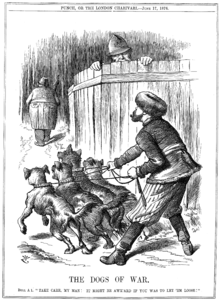 Russia preparing to release the Balkan dogs of war, while Britain warns him to take care. Punch cartoon from June 17, 1876
Russia preparing to release the Balkan dogs of war, while Britain warns him to take care. Punch cartoon from June 17, 1876
- On June 30, 1876, Serbia, followed by Montenegro, declared war on the Ottoman empire.
- On July 8 Russia's Alexander II and Prince Gorchakov met Austria-Hungary's Franz Joseph I and Count Andrássy in the Reichstadt castle in Bohemia. No written agreement was made, but during the discussions, Russia agreed to support Austrian occupation of Bosnia and Herzegovina, and Austria-Hungary, in exchange, agreed to the return of Southern Bessarabia lost by Russia during the Crimean War, and Russian annexation of the port of Batumi on the east coast of the Black Sea. Bulgaria was to become autonomous (independent, according to the Russian records).[33]
- In July–August, the ill-prepared and poorly equipped Serbian army helped by Russian volunteers failed to achieve offensive objectives but did manage to repulse the Ottoman offensive into Serbia, and on August 26, Serbia pleaded European powers to mediate in ending the war. A joint ultimatum by the European powers forced the Porte to give Serbia a one month truce and start peace negotiations. Turkish peace conditions however were refused by European powers as too harsh.
- In early October, after the truce expired, the Turkish army resumed its offensive and the Serbian position quickly became desperate. As a result, on October 31, 1876 Russia issued an ultimatum requiring the Ottoman Empire to stop the hostilities and sign a new truce with Serbia within 48 hours. This was supported by the partial mobilization of the Russian army (up to 20 divisions). The Sultan accepted the conditions of the ultimatum.
- To resolve the crisis, on December 11, 1876, the Constantinople Conference of the Great Powers was opened in Constantinople (to which the Turks were not invited). A compromise solution was negotiated, granting autonomy to Bulgaria, Bosnia and Herzegovina under the joint control of European powers. Turks, however, found a way to discredit the conference by announcing on December 23, the day the conference was closed, that a constitution was adopted that declared equal rights for religious minorities within the empire, based on which the Ottoman Empire announced its decision to disregard the results of the conference.
- On January 15, 1877, Russia and Austria-Hungary signed a written agreement confirming the results of an earlier oral agreement made at Reichstadt in July 1876. This assured Russia of the benevolent neutrality of Austria-Hungary in the impending war. These terms meant that in case of war Russia would do the fighting and Austria would derive most of the advantage. Russia therefore made a final effort for a peaceful settlement.
- On March 31, 1877, Russia persuaded the powers to sign the London Convention, which merely asked the Ottoman Empire to introduce those reforms which it had already proposed. The powers were to watch the operation of the reforms, and if conditions remained unsatisfactory they reserved the right "to declare that such a state of things would be incompatible with their interests and those of Europe in general". But the Turks felt themselves in a strong position and rejected the proposal on the grounds that it violated the Treaty of Paris.[34]
Prosecution: the one-eyed and the blind
Russia declared war on the Ottomans on 24 April 1877 and its troops entered Romania through the newly built Eiffel Bridge. The Prussian king Frederick II had sarcastically remarked a century earlier that a war between the Ottoman Empire and Russia would be "a war between the one-eyed and the blind".[35] This, however, was all too common a problem for contemporaneous warfare, from the Crimean War to the Boer Wars.
On April 12, 1877, Romania gave permission to the Russian troops to pass through its territory to attack the Turks, resulting in Turkish bombardments of Romanian towns on the Danube. On May 10, 1877, the Principality of Romania, which was under formal Turkish rule, declared its independence.[36]
At the beginning of the war, the outcome was far from obvious. The Russians could send a larger army into the Balkans: about 300,000 troops were within reach. The Ottomans had about 200,000 troops on the Balkan peninsula, of which about 100,000 were assigned to fortified garrisons, leaving about 100,000 for the army of operation. The Ottomans had the advantage of being fortified, complete command of the Black Sea, and patrol boats along the Danube river.[37] They also possessed superior arms, including new British and American-made rifles and German-made artillery.
In the event, however, the Ottomans usually resorted to passive defense, leaving the strategic initiative to the Russians who, after making some mistakes, found a winning strategy for the war.
The Ottoman military command in Constantinople made poor assumptions of Russian intentions. They decided that Russians would be too lazy to march along the Danube and cross it away from the delta, and would prefer the short way along the Black Sea coast. This would be ignoring the fact that the coast had the strongest, best supplied and garrisoned Turkish fortresses. There was only one well manned fortress along the inner part of the river Danube, Vidin. It was garrisoned only because the troops, led by Osman Pasha, had just taken part in defeating the Serbs in their recent war against the Ottoman Empire.
The Russian campaign was better planned, but it relied heavily on Turkish passivity. A crucial Russian mistake was sending too few troops initially; the Danube was crossed in June by an expeditionary force of about 185,000, which was slightly less than the combined Turkish forces in the Balkans (about 200,000). After setbacks in July (at Pleven and Stara Zagora), the Russian military command realized it did not have the reserves to keep the offensive going and switched to a defensive posture. The Russians did not even have enough forces to blockade Pleven properly until late August, which effectively delayed the whole campaign for about two months.
Course of the war
At the start of the war, Russia and Romania destroyed all vessels along the Danube and mined the river, thus ensuring that Russian forces could cross the Danube at any point without resistance from the Ottoman navy. The Ottoman command did not appreciate the significance of the Russians' actions. In June, a small Russian unit crossed the Danube close to the delta, at Galaţi, and marched towards Ruschuk, now known as Ruse. This made the Ottomans even more confident that the big Russian force would come right through the middle of the Ottoman stronghold.
Under the direct command of Major-General Mikhail Ivanovich Dragomirov, on the night of 27/28 June 1877 (New Style - N.S.) the Russians constructed a pontoon bridge across the Danube at Svishtov. After a short battle in which the Russians suffered 812 killed and wounded,[38] the Russian secured the opposing bank and drove off the Ottoman infantry brigade defending Svishtov. At this point the Russian force was divided into three parts: the Eastern Detachment under the command of Tsarevich Alexander Alexandrovich, the future Tsar Alexander III of Russia, assigned to capture the fortress of Ruschuk and cover the army's eastern flank; the Western Detachment, to capture the fortress of Nikopol, Bulgaria and cover the army's western flank; and the Advance Detachment under Count Joseph Vladimirovich Gourko, which was assigned to quickly move via Veliko Tarnovo and penetrate the Balkan Mountains, the most significant barrier between the Danube and Constantinople.
Responding to the successful Russian crossing of the Danube, the Ottoman high command in Constantinople ordered Osman Nuri Paşa to advance west from Vidin occupy the fortress of Nikopol, just west of the Russian crossing. On his way to Nikopol, Osman Pasha learned that the Russians had already captured the fortress and so moved to the crossroads town of Plevna (now known as Pleven), which he occupied with a force of approximately 15,000 on 19 July (N.S.).[39] The Russians, approximately 9,000 under the command of General Schilder-Schuldner, reached Plevna early in the morning. Thus began the Siege of Plevna.
Osman Pasha organized a defense and repelled two Russian attacks with huge casualties on the Russian side. At that point, the sides were almost equal in numbers and the Russian army was very discouraged.[40] Most analysts agree that a counter-attack would have allowed the Ottomans to gain control of, and destroy, the Russians' bridge[who?]. However, Osman Pasha had orders to stay fortified in Plevna, and so he did not leave that fortress.
Russia had no more troops to throw against Plevna, so the Russians besieged it, and subsequently asked[41] the Romanians to provide extra troops. Soon afterwards, Romanian forces crossed the Danube and joined the siege. On August 16, at Gorni-Studen, the armies (West Army group) around Plevna were placed under the command of the Romanian Prince Carol, aided by the Russian general Pavel Dmitrievich Zotov and the Romanian general Alexandru Cernat.
The Russians and the Romanians fought bravely to capture the redoubts around Pleven.[42][43] The Romanians managed to hold the Grivitsa redoubt, that they had captured earlier, until the very end of the siege. The siege of Plevna (July–December 1877) turned to victory only after Russian and Romanian forces cut off all supply routes to the fortified Ottomans. With supplies running low, Osman Pasha made an attempt to break the Russian siege in the direction of Opanets. On December 9, the Ottomans silently emerged, in the dead of the night, threw bridges over the Vit River and crossed it, attacked on a 2-mile (3.2 km) front and broke through the first line of Russian trenches. Here they fought hand to hand and bayonet to bayonet, with little advantage to either side. Outnumbering the Ottomans almost 5 to 1, the Russians drove the Ottomans back across the Vit. Osman Pasha was wounded in the leg by a stray bullet, which killed his horse beneath him. Rumours of his death created panic. Making a brief stand, the Ottomans eventually found themselves driven back into the city, losing 5,000 men to the Russians' 2,000. The next day, Osman surrendered the city, the garrison, and his sword to the Romanian colonel Mihail Cerchez. He was treated honorably, but his troops perished in the snows by the thousand as they straggled off into captivity. The more seriously wounded were left behind in their camp hospitals, only to be murdered by the Bulgarians.[44][dubious ]
At this point Serbia, having finally secured monetary aid from Russia, declared war on the Ottoman Empire again. This time there were far fewer Russian officers in the Serbian army but this was more than offset by the experience gained from the 1876–1877 war. Under nominal command of prince Milan Obrenović (effective command was in hands of general Kosta Protić, the army chief of staff), the Serbian army went on offensive in what is now eastern south Serbia. A planned offensive into the Ottoman Sanjak of Novi Pazar was called off due to strong diplomatic pressure from Austria-Hungary, which wanted to prevent Serbia and Montenegro from coming into contact, and which had designs to spread Austria-Hungary's influence through the area. The Ottomans, outnumbered unlike two years before, mostly confined themselves to passive defence of fortified positions. By the end of hostilities the Serbs had liberated Ak-Palanka (today Bela Palanka), Pirot, Niš and Vranje.
Russians under Field Marshal Joseph Vladimirovich Gourko succeeded in capturing the passes at the Stara Planina mountain, which were crucial for maneuvering. Next, both sides fought a series of battles for Shipka Pass. Gourko made several attacks on the Pass and eventually secured it. Ottoman troops spent much effort to recapture this important route, to use it to reinforce Osman Pasha in Pleven, but failed. Eventually Gourko led a final offensive that crushed the Ottomans around Shipka Pass. The Ottoman offensive against Shipka Pass is considered one of the major mistakes of the war, as other passes were virtually unguarded. At this time a huge number of Ottoman troops stayed fortified along the Black Sea coast and engaged in very few operations.
Besides the Romanian Army (which mobilized 130,000 men, losing 10,000 of them to this war), a strong Finnish contingent and more than 12,000 volunteer Bulgarian troops (Opalchenie) from the local Bulgarian population as well as many hajduk detachments fought in the war on the side of the Russians. To express his gratitude to the Finnish battalion, the Tsar elevated the regiment on their return home to the name Old Guard Battalion, which they still hold.
The Caucasian Front
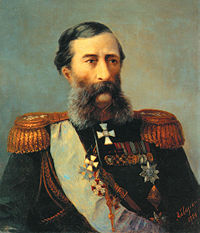 General Mikhail T. Loris-Melikov, whose forces seized the fortress of Kars from the Ottomans in November 1877.
General Mikhail T. Loris-Melikov, whose forces seized the fortress of Kars from the Ottomans in November 1877.
Stationed in the Caucasus in Georgia and Armenia was the Russian Caucasus Corps, composed of approximately 75,000 men under the overall command of Grand Duke Michael Nikolaevich, Governor General of Caucasus. The Russian force stood against an Ottoman army of 80,000 men led by General Ahmed Muhtar Pasha.[45] While the Russian army was better prepared for the fighting in the region, it lagged behind technologically in certain areas such as heavy artillery and was outgunned, for example, by the superior Krupps artillery that Germany had supplied to the Ottomans.[46]
Many of the Russian commanders under Michael Nikolaevich were of Armenian descent, including generals Beybut Shelkovnikov, Mikhail Loris-Melikov, Ivan Lazarev and Arshak Ter-Ghukasov.[47] It was the forces under Lieutenant-general Ter-Ghukasov, stationed near Yerevan, who began the first assault into Ottoman territory by capturing the town of Bayazid on April 27, 1877.[45] Capitalizing on Ter-Ghukasov's victory in Bayazid, Russian forces advanced further, taking the region of Ardahan on May 17; Russian units also besieged the city of Kars in the final week of May, although Ottoman reinforcements lifted the siege and drove them back. War conditions in western Armenia also reciprocated against the Armenian population: in some areas, the Turks encouraged the Kurds to attack the Armenians and in Bayazit and Alashkert.[48]
In February 1878, the Russians took Erzurum without resistance. Although the Russians relinquished control over Erzerum to the Ottomans at the end the war, they took Ardahan, Kars, Olti, Sarighamish and other regions into their possession and reconstituted them as parts of the Kars Oblast.[49]
Aftermath
Intervention by the Great Powers
Under pressure from the British, Russia accepted the truce offered by Ottoman Empire on January 31, 1878, but continued to move towards Constantinople.
The British sent a fleet of battleships to intimidate Russia from entering the city, and Russian forces stopped at San Stefano. Eventually Russia entered into a settlement under the Treaty of San Stefano on March 3, by which the Ottoman Empire would recognize the independence of Romania, Serbia, Montenegro, and the autonomy of Bulgaria.
Alarmed by the extension of Russian power into the Balkans, the Great Powers later forced modifications of the treaty in the Congress of Berlin. The main change here was that Bulgaria would be split, according to earlier agreements among the Great Powers that precluded the creation of a large new Slavic state: the northern and eastern parts to become principalities as before (Principality of Bulgaria and Eastern Rumelia), though with different governors; and the Macedonian region, originally part of Bulgaria under San Stefano, would return to direct Ottoman administration.[34]
Effects on Romania
Effects on Bulgaria's Muslim and Christian population
The estimates of Muslim civilian casualties during the war range from possibly tens of thousands[50] to 260,000 to 262,000 Muslims, almost entirely Turkish, according to the American historian Justin A. McCarthy,[51] who is widely considered to have pro-Turkish views.[52] The perpetrators of those massacres are also disputed, with McCarthy claiming that they were carried out by Russian soldiers, Cossacks as well as Bulgarian volunteers and villagers, while they were few civilian casualties in battle,[53] while James J. Reid claims that Circassians, were significantly responsible for the refugee flow, that there were civilian casualties from battle and even that the Ottoman army was responsible for casualties among the Muslim population.[54] According to John Joseph the Russian troops made frequent massacres of Turkish peasants to prevent them distrupting their supply and troop movements. During the disputed Harmanli Massacre, it was claimed a huge group of Muslim refugees were attacked by the Russian army, as a result that thousands of Muslim refugees died and their goods plundered.[55][56] The correspondent of the Daily News describes as an eyewitness the burning of 4 or 5 Turkish villages by the Russian troops in response of the Turks firing at the Russians from the villages, instead of behind rocks or trees. [57]
The number of Muslim refugees is estimated by R.J.Crampton as 130,000,[58] while McCarthy estimates that the total was 515,000, almost all Turkish. Richard C. Frucht estimates that only half (700,000) of the prewar Muslim population remained after the war, 216,000 had died and the rest emigrated.[59] Douglas Arthur Howard estimates that half the 1,5 million Muslims, most part Turks in prewar Bulgaria had disappeared by 1879. 200,000 had died, the rest became permanently refugees in Ottoman territories.[60] However, it should be noted that according to one estimate, the total population of Bulgaria in its postwar borders was about 2800 thousands in 1871,[61] while according to official censuses, the total population was 2823 thousands in 1880/1881.[62]
During the conflict a number of Muslim buildings and cultural centres were destroyed. A large library of old Turkish books was destroyed when a mosque in Turnovo was burned in 1877.[63] Most mosques in Sofia perished, seven of them destroyed in one night in December 1878 when a thunderstorm masked the noise of the explosions arranged by Russian military engineers."[64]
Тhe Christian population, especially in the initial stages of the war, that found itself in the path of the Ottoman armies also suffered greatly.
This was particularly true after the July battle around Stara Zagora when Gurko's forces had to retreat back to the Shipka pass. In the aftermath of the battle Suleiman Pasha burned down the town of Stara Zagora which by that time was one of the largest towns in the Bulgarian lands. He also established in the whole valley of the Maritsa river a system of hanging at the street corners of every Bulgarian who had in any way assisted the Russians, but even villages who had not assisted the Russians were destroyed and their inhabitants massacred[65] As a result as many as 100,000 civilian Bulgarians fled north to the Russian occupied territories.[66] Later on in the campaign the Ottoman forces planned to burn the town of Sofia after Gurko had managed to overcome their resistance in the passes of Western part of the Balkan Mountains. Bulgarian historians claim that 30000 civilian Bulgarians were killed during the war, of which two thirds in the Stara Zagora area[67] Only the refusal of the Italian Consul Vito Positano, the French Vice Consul Léandre François René le Gay and the Austro–Hungarian Vice Consul to leave Sofia prevented that from happening. After the Ottoman retreat, Positano even organized armed detachments to protect the population from marauders (regular Ottoman Army deserters, bashi-bazouks and Circassians).[68]
Effects on Bulgaria's Jewish population
Many Jewish communities in their entirety were forced to flee with the retreating Turks as their protectors. The Bulletins de l'Alliance Israelite Universelle reported that thousands of Bulgarian Jews found refuge at the Ottoman capital of Constantinople (Istanbul).[69][not in citation given]
Lasting impact
International Red Cross and Red Crescent Movement
This war caused a division in the emblems of the International Red Cross and Red Crescent Movement which continues to this day. Both Russia and the Ottoman Empire had signed the First Geneva Convention (1864), which made the Red Cross, a color reversal of the flag of neutral Switzerland, the sole emblem of protection for military medical personnel and facilities. However, during this war the cross instead reminded the Ottomans of the Crusades; so they elected to replace the cross with the Red Crescent instead. This ultimately became the symbol of the Movement's national societies in most Muslim countries, and was ratified as an emblem of protection by later Geneva Conventions in 1929 and again in 1949 (the current version).
Iran, which neighbors both countries, considered them to be rivals, and probably considered the Red Crescent in particular to be an Ottoman symbol; except for the Red Crescent being centered and without a star, it is a color reversal of the Ottoman flag (and the modern Turkish flag). This appears to have led to their national society in the Movement being initially known as the Red Lion and Sun Society, using a red version of The Lion and Sun, a traditional Iranian symbol. After the Iranian Revolution of 1979, Iran switched to the Red Crescent, but the Geneva Conventions continue to recognize the Red Lion and Sun as an emblem of protection.
The impact of this division later led to the Magen David Adom controversy, which was resolved partly through the addition of yet another emblem of protection, the Red Crystal, by Protocol III.
Gallery
-
Muslim refugees in Hagia Sophia
-
Distribution Clothing to Turkish refugees in Shumen
-
Signing the treaty of San Stefano
-
Surrender of Osman Pasha in Plevna
See also
- Battles of the Russo-Turkish War (1877–1878)
- Ottoman fleet organisation during the Russo-Ottoman War of 1877–78
- Harmanli Massacre
- History of the Balkans
- "The Turkish Gambit"
References
- ^ This is the number of soldiers who took an active part in military engagements. The total size of the Russian regular army as of 1 January 1877 reached 1 005 828.
- ^ (Russian) Мерников А. Г., Спектор А. А. Всемирная история войн. — Минск: 2005. — С. 376.
- ^ (Russian) Урланис Б. Ц. Войны и народонаселение Европы. — М.: 1960.
- ^ (Romanian) Scafes, Cornel, et. al., Armata Romania in Razboiul de Independenta 1877–1878 (The Romanian Army in the War of Independence 187-1878). Bucuresti, Editura Sigma, 2002, p. 149
- ^ See the full text of Hatt-ı Hümayun
- ^ Vatikiotis, P. J. The Middle East. London: Routledge, 1997, p. 217 ISBN 0-415-15849-4
- ^ "The Eastern question from the Treaty of Paris 1836 to the Treaty of Berlin 1878 and to the Second Afghan War ([1879])" chapter 2
- ^ Finkel, Caroline. The History of the Ottoman Empire. New York: Basic Books, 2005, p. 467.
- ^ a b Country Studies: Lebanon, U.S. Library of Congress, 1994
- ^ p. 219 of "The Druzes and the Maronites under the Turkish rule from 1840 to 1860" by C. Churchill, London: B.Quaritch, 1862
- ^ Shaw, Stanford J. and Ezel Kural Shaw. History of the Ottoman Empire and Modern Turkey: Volume 2, Reform, Revolution, and Republic: The Rise of Modern Turkey 1808–1975. Cambridge: Cambridge University Press, 1977, pp. 142–143 ISBN 0-521-29166-6.
- ^ The Historical Journal, Vol. 3, No. 1 (1960), pp. 38–55
- ^ Stillman, William James. The Autobiography of a Journalist, Volume II. The Project Gutenberg eBook released on March 15, 2004 eBook#11594
- ^ «The Eastern question from the Treaty of Paris 1836 to the Treaty of Berlin 1878 and to the Second Afghan War», page 122, by Argyll, London Strahan 1879
- ^ Shaw and Shaw. History of the Ottoman Empire, p. 146.
- ^ Crampton, R.J. "Bulgaria", p. 114. Published 2007, Oxford University Press.
- ^ Lord Kinross, The Ottoman Centuries, 1977, pp. 509, Morrow Quill
- ^ Hupchick, p. 263
- ^ The Eastern question: from the treaty of Paris, 1856, to the treaty of Berlin, 1878, and to the second Afghan war; George Douglas Campbell Argyll; 2005, p.229
- ^ Hupchick: 2002, p. 264
- ^ a b c Genocide and gross human rights violations: in comparative perspective, Kurt Jonassohn, 210 pp. 209-210
- ^ The Turkish empire from 1288 to 1914, Baron George Shaw-Lefevre Eversley, 1924, p.319
- ^ Genocide and gross human rights violations: in comparative perspective, Kurt Jonassohn, 1999, p.210
- ^ New Statesman: Volume 6, p.202
- ^ The establishment of the Balkan national states, 1804-1920; Charles Jelavich, Barbara Jelavich; 1986, p.139
- ^ Bulgarian horrors and the question of the east by W.E. Gladstone
- ^ Gladstone, William Ewart. Bulgarian Horrors and the Question of the East. London: William Clowes and Sons, 1876, p. 64.
- ^ Dennis Hupchick, The Balkans, 2002, p. 264, Palgrave
- ^ History of Bulgaria — The liberation of Bulgaria, from the website of Bulgarian embassy in the US
- ^ Bulgarian horrors and the question of the east by W.E. Gladstone, page 9.
- ^ Bulgarian horrors and the question of the east by W.E. Gladstone, page 28.
- ^ (Russian) В. М. Хевролина, Россия и Болгария: «Вопрос Славянский — Русский Вопрос»
- ^ «History of world diplomacy XV century BC — 1940 AD» by Potemkin V. P.
- ^ a b Online Chapter on the War, from the book "The Balkans Since 1453" by Stavrianos
- ^ William Cooke Taylor and Caleb Sprague Henry, A Manual of Ancient and Modern History. New York: D. Appleton & Co., 1845, p. 628.
- ^ Chronology of events from 1856 to 1997 period relating to the Romanian monarchy on Kent State University website, Ohio, United States
- ^ The war in the East. An illustrated history of the conflict between Russia and Turkey with a review of the Eastern question (1878) by Schem, A. J.]
- ^ Bayonets before Bullets: The Imperial Russian Army, 1861–1914, Bruce Menning, Indiana University Press, 2000, p. 57
- ^ The Defense of Plevna 1877, Frederick William von Herbert, Longmans, Green, and Co, London, 1895, p. 131
- ^ "Reminiscences of the King of Roumania", ed. Harper&Brothers 1899, pp. 274–275 http://www.archive.org/stream/reminiscencesofk00kremiala#page/274/mode/2up
- ^ "Reminiscences of the King of Roumania", ed. Harper&Brothers 1899, pp. 275 http://www.archive.org/stream/reminiscencesofk00kremiala#page/274/mode/2up
- ^ Furneaux, Rupert. The Siege of Pleven. 1958.
- ^ # Herbert, William. «The Defense of Pleven, 1877»
- ^ Lord Kinross, The Ottoman Centuries, 1977, p. 522, Morrow Quill
- ^ a b (Armenian) Anon. «Ռուս-Թուրքական Պատերազմ, 1877–1878» (The Russo-Turkish War, 1877–1878). Armenian Soviet Encyclopedia. vol. x. Yerevan: Armenian Academy of Sciences, 1984, pp. 93–94.
- ^ Allen, William E.D.; Paul Muratoff (1953). Caucasian Battlefields. Cambridge: Cambridge University Press. pp. 113–114.
- ^ Allen and Muratoff. Caucasian Battlefields, p. 546.
- ^ For an overall description of the plight of the Armenians during the war and the subsequent internationalization of the Armenian Question, see Richard G. Hovannisian, "The Armenian Question in the Ottoman Empire, 1876-1914" in The Armenian People From Ancient to Modern Times, Volume II: Foreign Dominion to Statehood: The Fifteenth Century to the Twentieth Century. Richard G. Hovannisian (ed.) New York: St. Martin's Press, pp. 206-212. ISBN 0-312-10168-6.
- ^ (Armenian) Hakobyan, Tadevos Kh. (2007). Հայաստանի Պատմական Աշխարհագրություն (Historical Geography of Armenia). Yerevan: Yerevan State University Press. p. 422.
- ^ Genocide in the Age of the Nation State: The rise of the West and the coming of genocide, Mark Levene, 2005, p.225
- ^ McCarthy, J., Death and Exile: The Ethnic Cleansing of Ottoman Muslims, 1821–1922, (Princeton, N.J: Darwin Press, c1995), 64, 85
- ^ Michael Mann, ”The dark side of democracy: explaining ethnic cleansing”, pp. 112-4, Cambridge, 2005 “… figures are derive[d] from McCarthy (1995: I 91, 162-4, 339), who is often viewed as a scholar on the Turkish side of the debate.”
- ^ McCarthy, J., The Ottoman Peoples and the end of Empire, 2001, p. 48, Oxford University Press
- ^ Crisis of the Ottoman Empire: prelude to collapse 1839-1878, James J. Reid, 2000 pp.42-43
- ^ The Congress of Berlin and after, William Norton Medlicott, page 157
- ^ Muslim-Christian Relations and Inter-Christian Rivalries in the Middle East, John Joseph, page 84, 1983
- ^ Crisis of the Ottoman Empire: prelude to collapse 1839-1878, James J. Reid, page 324, 2000
- ^ Crampton, R.J., A Concise History of Bulgaria, 1997, Cambridge University Press ISBN 0-521-56719-X, p.426
- ^ Eastern Europe, Richard C. Frucht, page 641, 2005
- ^ The history of Turkey, Douglas Arthur Howard, page 67, 2001
- ^ http://www.populstat.info/Europe/bulgaric.htm
- ^ Bulgaria, R. J. Crampton, 2007, p.424
- ^ Crampton, R.J., A Concise History of Bulgaria, 2006, pp. 111, Cambridge University Press. ISBN 0-521-85085-1
- ^ Crampton, A Concise History of Bulgaria, p. 114.
- ^ The Eastern Question from the Treaty of Paris 1856 to the Treaty of Berlin 1878 and to the Second Afghan War. Volume 2; George Douglas Campbell Argyll; p.49
- ^ Francis Vinton Greene,Report on the Russian Army and its Campaigns in Turkey in 1877-1878. D. Appleton and Company. 1879. p. 204.
- ^ Russian-Turkish war 1877-1878, Bozhidar Dimitrov, 2002, p.75 (in Bulgarian)
- ^ Иванов, Димитри (2005-11-08). "Позитано. "Души в окови"" (in Bulgarian). Сега. http://www.segabg.com/online/article.asp?issueid=315§ionid=4&id=00004. Retrieved 2009-04-30.
- ^ Tamir, V., Bulgaria and Her Jews: A dubious symbiosis, 1979, p. 94–95, Yeshiva University Press
Further reading
- Acar, Keziban (March 2004). "An examination of Russian Imperialism: Russian Military and intellectual descriptions of the Caucasians during the Russo-Turkish War of 1877–1878". Nationalities Papers 32 (1): 7–21. doi:10.1080/0090599042000186151.
External links
- (English) Online Chapter on the War, from the book "The Balkans Since 1453" by Stavrianos
- (English) Virtual War, Virtual Journalism?: Russian Media Responses to ‘Balkan’ Entanglements in Historical Perspective, 1877-2001 by Steven J. Seegel, Brown University (USA)
- (English) Military History: Russo-Turkish War (1877–1878)
- (English) Twenty Five Lectures On Modern Balkan History by Steven W. Sowards
- (Russian) Russian website on the war
- (English) The Romanian Army of the Russo-Turkish War 1877–1878
- (Russian) Text of the book Russo-Turkish War of 1877–1878 and the Exploits of Liberators
- (Bulgarian) Image gallery for the war
Video links
130 years Liberation of Pleven (Plevna)
- Speech at 3 March 2007 of Mayor of Pleven – Mr. Najden Zelenogorsky
- Speech at 3 March 2007 of Bulgarian Prime Minister - Sergej Stanishev
- Speech at 3 March 2007 of Mr. Potapov, Ambassador of Russia in Bulgaria
Diplomacy of the great powers 1871–1913 Great powers Treaties and agreements Treaty of Frankfurt · League of the Three Emperors · Treaty of Berlin · German-Austrian Alliance · Triple Alliance · Reinsurance Treaty · Franco-Russian Alliance · Treaty of Paris · Anglo-Japanese Alliance · Entente cordiale · Treaty of Björkö · Taft–Katsura Agreement · Japan–Korea Treaty of 1905 · Anglo-Russian Entente · Triple Entente · Japan–Korea Annexation Treaty · Racconigi agreementEvents The Great Game · Pan-Slavism · Russo-Turkish War · Congress of Berlin · Scramble for Africa (Berlin Conference) · First Sino-Japanese War · German Naval Laws · Fashoda Incident · Spanish–American War · Annexation of Hawaii · Banana Wars · Philippine–American War · Boxer Rebellion · Boer War · Russo-Japanese War · First Moroccan Crisis · Dreadnought · Agadir Crisis · Bosnian crisis · Italo-Turkish War · Balkan WarsCategories:- Russo-Turkish War (1877–1878)
- Modern history of Bulgaria
- Wars involving Montenegro
- Wars involving Romania
- Russo-Ottoman Wars
- 1877 in Bulgaria
- 1878 in Bulgaria
- 1870s in Turkey
Wikimedia Foundation. 2010.

